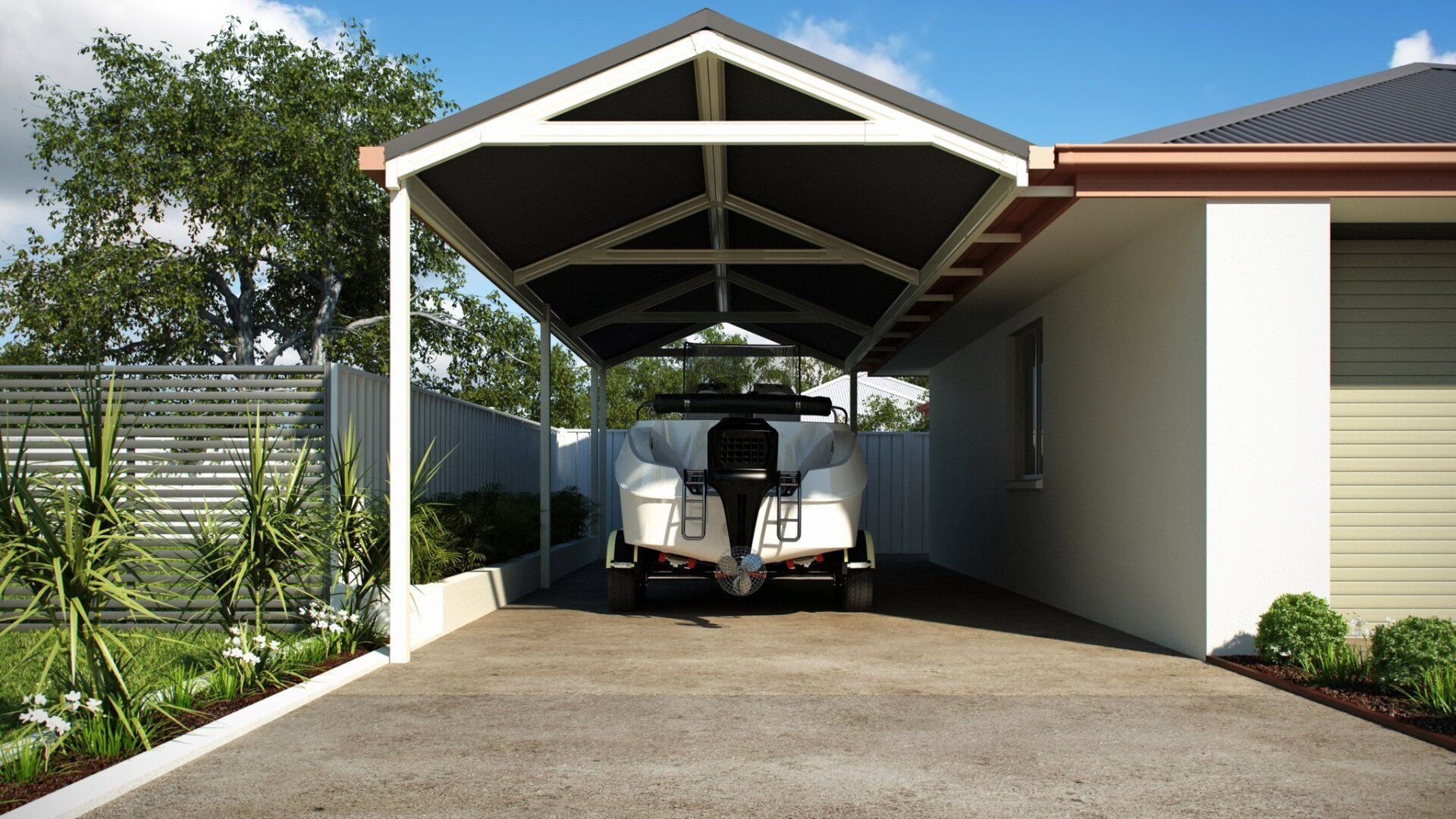Blog

What are the different types of carports? Most people have spent their savings or credit cards on a car. Cars depreciate rather than appreciate, necessitating regular user maintenance. Despite the owners' best efforts, cars are still damaged. Paint can be damaged and corroded by high winds. Rain, tree sap, sun, bird droppings, and debris can also shatter the windshield. On the other hand, a carport can provide a low-cost way to shelter your vehicle while also keeping it cool on hot days and saving you time on icy mornings. What Is A Carport? A carport is a semi-covered structure with a fabric or steel roof usually supported by steel supports. Carports have roofs but no doors, unlike garages. A carport can improve the appearance of any outdoor space. Surprisingly, these low-maintenance open-style structures are ideal for any outdoor space. Some carports are attached to houses, garages, or other structures. According to Brisbane Carport Builders , an attached carport is a great option for people who have a garage but need more space for other vehicles. Carports are useful throughout the year, and they are resistant to natural erosion and some of the most severe weather conditions. Carports not only protect cars, but they also provide shade. Most Common Carport Types Gable Roof A Gable carport's roof has two slanted sides and a gable at each end. When properly designed and built, this carport will appear to be a natural extension of your home. Because of its unique blend of historic elegance and clean aesthetics, a Gable roof carport is also a pitched roof. It is the most common type of carport. It has a triangular structure, with each corner bending downwards. It works well in areas with a lot of rain or snow. This is the most common type of carport and home in general. Slate shingles, asphalt, and wood shake are among the materials used. The standard roof pitch is 15 degrees, but it can be adjusted to other degrees, such as 10 degrees. The Dutch Gable This is a standard gable roof with parapets. Dutch gable carports are ideal for heritage and colonial structures, and they also make an excellent choice for an entertaining outdoor area. You can welcome all of your family and friends while keeping them safe from the sun and rain under this sturdy, shaded patio. Skillion Carports Skillion rooftop garages are a single, flat sheet. However, unlike level surfaces, they are constantly worked at a point – this takes into account water run-off. It is a rooftop pitch that allows you to catch the sun's rays efficiently. The skillion roof is extremely easy to work with because it is made of a single sheet, making it simple to construct. Compared to gable roof carports and hip roofs, it also uses fewer materials, making it a more cost-effective option. Because this carport only has one board, smaller ranges are possible than a gable roof carport. You can also alter the pitch and height of your parking spot. Flat Roof Carports Your garage ought not just to shield your vehicle from the sun, downpour, and other destructive components. Instead, it needs to likewise assist with improving the outside perspective on your home. The building allure of flat roof carports increases the value of your property. Ordinarily, a flat roof carport will not require extra support outside of the standard casing. Hence, it remains outwardly perfect and open. Likewise, you'll observe that flat roof carports are steadier and a lot more straightforward to access than more slanted garages. Since they are level, they are easier to clean. A flat roof carport is easy to keep up with, but it also has a calculated rooftop pitch that allows leaves and other garbage to move off and not build up on the surface. Freestanding Carports Freestanding carports are the cheapest, simplest, and quickest carport type. Because attached carports pose significant concerns, a freestanding carport is a popular choice among most homeowners. The casing is assembled and finished off with a rooftop with an open-sided carport. This will assist with shielding your vehicle from sun harm, downpour, and hail. However, it may not shield it from extremely hazardous or savage storms. An open-sided carport is a superb choice when you need something modest and speedy that will do with no additional ornamentations. Hip Roof Carports A square hip roof has a pyramid shape. However, you can use a rectangular hip roof with two triangular and trapezoidal sides on carports. A hip roof has four faces and a flat top on a rectangular plan. They are symmetrical around the centre lines since they are always the same pitch or slope. The standard pitch of a hip roof carport is 22 degrees, although it can be 'customized' to be steeper. A continuous level fascia is common on hip roof carports as it allows you to fit a gutter all the way around. Hip roofs are intrinsically more secure than gable roofs since they don't have big, flat, or slab-sided ends to catch the wind. Compared to a gable roof carport, a hip roof carport is self-bracing and requires less diagonal bracing. Gable roof carports are not as well adapted to strong wind or cyclonic locations as hip roof carports are.

What is a Good Size for a Carport? Even if you've decided that a metal carport is the best option for storing your vehicle, you must choose the appropriate size. Carports can be built in almost any custom configuration, but a few standard widths are based on manufacturing methods and materials. Choosing the correct width, length, and height depends on how many vehicles you'll be storing in the same structure. These structures can protect anything from a single compact car to a fleet of heavy equipment, so keep these common size categories in mind when making your choice. Standard Single Vehicle A basic one vehicle carport must have a minimum width of 12 feet to accommodate a passenger car, truck, or van. This is enough space for doors on both sides of the vehicle to open without colliding with the walls fully. 14 and 16-foot widths are also famous for single-vehicle carports with extra storage space. Extra-wide garage doors may necessitate a broader carport to support the frame's weight. Double Wide Options If you want to store at least two vehicles side by side simultaneously, you'll need a carport that's 18 to 24 feet wide. Only compact cars will fit comfortably at 18 feet, whereas most passenger cars, smaller SUVs, and small trucks will fit 20 to 22 feet. Full-sized vans and trucks may require 24 feet of width to open both vehicles' doors without colliding. Twin sets of matching garage doors can be easily centred on any even-numbered width measurement, but when checking carport layouts, keep in mind the space required for accessories like powered lifts and automated sensors. Sizing for Trucks and Oversized Vehicles When storing service body trucks, cargo vans, and other oversized vehicles in your home or business carport , you'll need to expand your carport's width and length. The standard length of the smallest carport is 21 feet, but you can generally extend or shrink the length by any amount in 5-foot increments. Because commercial vehicles and heavy equipment are typically longer than standard trucks and cars, a length of 26 or 31 feet is often a better choice. Extending the length is also a good option for extra storage in front of the vehicle, particularly if you plan to instal permanent shelving and cabinets against an end wall. Commercial Storage Options If you're storing a crane truck, front end loader, or other large commercial equipment, you'll almost certainly need a height boost. If you stick with a standard carport design, extra width and length will not compensate for a low door height. Increase the height by at least 3 to 5 feet for vehicles with truck bed additions such as cranes and booms and up to 10 to 12 feet for box trucks and other tall vehicles. Take accurate measurements of a vehicle's highest point, then add at least 4 to 5 feet to the total height so that the side height is adequate for a door with a lot of vertical space. RV Height and Width Considerations RVs and fifth wheel campers can require oversized doors with a minimum height of 9 to 12 feet to compensate for attached antennas, satellite dishes, and roof-mounted AC units. This isn't just added to the total roof height but just to the door height itself. This means that the carport may need even more height to leave enough of a slope on the roof to shed water rapidly. RVs also tend to push the maximum 8-foot width for road-legal vehicles, requiring a 16 to 20-foot carport width rather than a minimal 12-foot width. Measure the total length of the RV and add 4 to 8 feet so you can pull in easily without squeezing too close to the front wall to close the door. Top Height and Side Height Finally, don't forget that the total top height of the roof's peak is different from the side height. Side heights measure the highest point of the side walls, limiting the height of the garage doors installed on the structure. If you have a 9 foot tall RV and buy a carport that only has a maximum top height of 10 feet at the roof, your RV is unlikely to make it through the bay door. Check both the top and side height of a structure before assuming it will fit a particular vehicle inside of it. With these figures, you should have a rough idea of the measurements you need for your carport. Try laying out the various sizes with some contractor's tape to get a feel for various combinations of dimensions.

